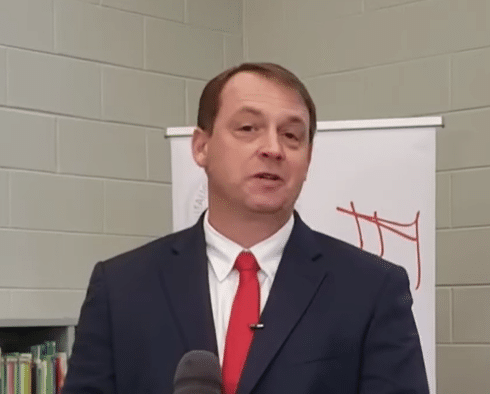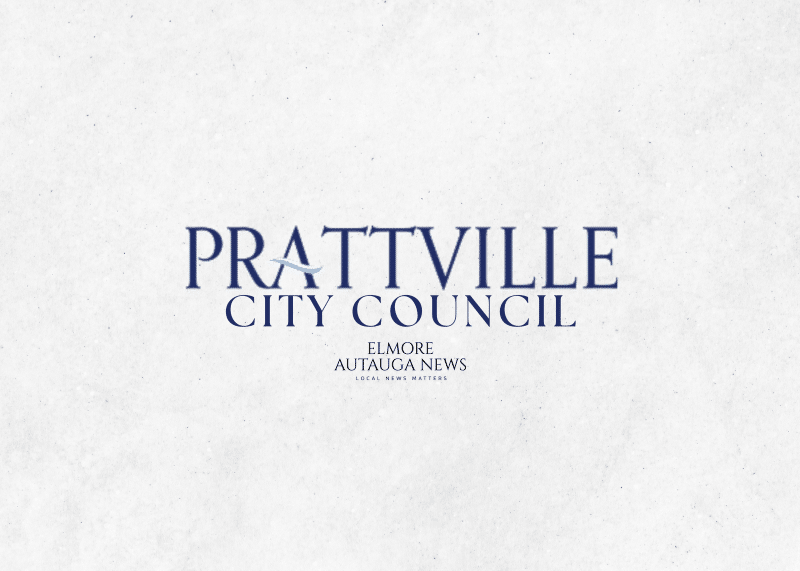By Sarah Stephens
Elmore Autauga News
Top Photo: File photo of Supt. Lyman Woodfin
Autauga School Superintendent Lyman Woodfin recently met with the Prattville City Council on Tuesday, proposing a collaborative approach to help secure future funding for the school system.
Woodfin highlighted that 60 percent of all students within the Autauga County School system reside in Prattville.
“I hope I can point out some ideas for collaboration that can not only help the students and educators but also help drive economic development for all of Autauga County. I am very proud of the progress we are making in Autauga County Schools. I appreciate the partnership that you guys work with us every day to get things done. We have had to make very difficult decisions recently, but we are doing a little better financially. I feel like we are moving in the right direction, and I feel very good with our academic progress. We are doing a lot of great things,” Woodfin stated.
Regarding discussions, he mentioned two significant facility challenges that the schools cannot resolve independently. These involve the condition of existing school buildings within the City of Prattville and the substantial growth occurring in the areas of Marbury and Pine Level.
Woodfin informed the council on Tuesday that while he has been speaking elsewhere in the county about other issues, his focus for this presentation would be on matters specifically affecting Prattville.
He distributed information packets to each council member, indicating that he had several ideas he wished to present.
“We have not had a board meeting (about these issues) or approved anything in this document. This is me being here all my life. I am a product of the system.”

Woodfin explained that he wanted to address the council and share some preliminary ideas following the school board’s recent Criterion study, exploring how partnerships might help address some revenue deficiencies.
Discussing the current financial situation and constraints, he noted, “We have stabilized our day-to-day operations somewhat. There are a lot of hard decisions that have been made.” He cited the closure of Autaugaville School as one such decision.
There have been ongoing conversations about a potential bond issue, which could provide funds for necessary repairs to school buildings and the construction of new facilities for the Autauga County public education system.
Woodfin addressed the common question about the absence of a new high school for Prattville. He clarified that borrowing $25 million costs approximately $1.6 million in bond payments annually. An estimated cost for a new high school is around $150 million, which would translate to an annual bond payment of roughly $9.8 million today. Woodfin stated that while the Board has managed to achieve about a $2 million budget surplus, this still leaves a substantial funding gap.
“That is why you don’t see a lot of new buildings, that is why you haven’t over the last several years. The same issues my board have are the same issues that we have had in the county for a long time.”
He presented concepts outlining how the city and the school board could collaborate on solutions. He also mentioned having already approached the Autauga County Commission and the Town of Pine Level regarding these potential partnerships.
“In the perfect world, the Autauga County Board of Education works with the City of Prattville, the Autauga County Commission, and the Town of Pine Level. Obviously the more you work together, you share some of the cost burden. You also honestly can get more of a bond at a lower rate. Obviously, that is what we would like to do if that is ever possible.”
Woodfin indicated that the Board anticipates paying off some existing bond issues by 2029. This would allow the board to potentially increase its contribution towards servicing a new bond at that time.
In one proposed scenario, the Board would commit $2 million annually, with plans to increase this amount after 2029. Speaking in round figures, he discussed potential bond payments and the structure of a partnership. Prattville might contribute $8 to 10 million, the County Commission $1 to 3 million, with the Town of Pine Level also participating, though their exact level of involvement is unclear as they are a newly incorporated town.
Woodfin confirmed that financial agreements involving multiple government entities like this are not uncommon across the state.
“It is prevalent…this is something that does occur,” Woodfin said. “The Autauga County Board of Education cannot build a new school in the city of Prattville until at least 2029. It is more like 2032-33 based off projections.”
Woodfin noted a decline in enrollment within Prattville schools over the past several years.
“Part of that is choice, another part is because if you ask our parents they will tell you, the dual feeder pattern causes problems sometimes if they have multiple kids, they want to go to Daniel Pratt. That is what we have seen in our in-district transfer applications. A lot of our parents in Prattville are leaving central zoned schools and going to Daniel Pratt because Mom works in Montgomery and they can drop off their kids there. It is nothing about the schools, it is just easier for them.”
He emphasized that school choice is now a reality, and delaying solutions to parental concerns about facilities could result in further student losses for the system. A decrease in students leads to a reduction in teaching units, which might necessitate the school board considering school consolidation.
“That is the reality of the Choose Act. That is the reality of education right now. That is why it is so important to try and solve what the parents say need to be solved.”
If the Board were able to construct a new high school, Woodfin suggested it would provide greater flexibility regarding future feeder patterns.
“More importantly, we talk a lot about economic development. We talk a lot about getting kids ready for life. The idea we have is if we could build a new high school, and tailor it to what our military families are asking for. This community was built many years ago on the backs of all of our families, but especially our military families coming in.”
Woodfin mentioned that military families often inquire about programs such as the international baccalaureate program or specific pathways preparing students for military careers. While the system has a strong ROTC program, he posed the question: “But is there really a school in the state of Alabama that makes it one of their pillars of ‘We are going to have a military preparedness wing in the high school?’ That is what we would like to do…focus on that portion.”
If a new school were built, he said dual enrollment and career tech programs would also be integrated. He also highlighted the advantage of working with Central Alabama Community College (CACC).
“There are a lot of things we can do to work together. The time is now as far as economic development. If we can figure out a way to all partner together to make this happen, we start to change the dynamics of education in this city and in the county. There is a part of this as well…there is a pride factor here as well. I am taking a lot of pride in this, because this is home. I am never going to shy away from that. I am a product of the system; you are as well. This is our home. I think if we can solve the facility issues. I feel very good where we are headed and where we are going.”
Woodfin clarified that he was not requesting an immediate commitment from the city but rather that the council remain receptive to the ideas presented.
“After the Ad Valorem was defeated, I was tasked by all entities with ‘Hey, can you work with something else? Can you bring us something?’ There has been a lot of time and research with the packet you have.”
Councilman Robert Strichik commended Woodfin’s passion. “Most everybody in this room and our community knows the dire situation we are in or headed toward. I have said in the past, this is a unique opportunity partnering with CACC, sharing staff and facilities. And military training…there wouldn’t be anything like this in the state of Alabama.”
Strichik noted Prattville’s continued growth and stated his belief that it is the council’s responsibility to find ways to support education.
“We need to work together as a city, and a county to help you guys be as successful as you can. If you are successful, we are all more successful. We help with the military, economic strength, the whole ball of wax. We are at a crossroads in my opinion on which way we are going to go. Are we just going to be whatever we are or are we going to improve?”
Strichik expressed his strong support for finding a path forward to improve the education system.
Woodfin sought to clarify the possibility of a partnership with CACC, stating that while numerous discussions have taken place, nothing has been finalized.
“This is a dream that Mr. Lynn and I have talked a lot about. But until I can solidify the funding side of it, there will never be an agreement. If it ever got to the point where we could do something on his campus, it does open up the door to a lot of possibilities. But I just want to make sure everyone understands, it is not a done deal or a guarantee. I can’t get to that point until I secure the funding.”
Regardless of whether a formal agreement between the board and CACC materializes, Woodfin praised the institution as a “game changer” and noted CACC’s strong support. He commended the Council’s work with CACC which contributed to the college’s decision to locate in Prattville.
Councilman Marcus Jackson recalled that in 2018, the council established a committee to begin researching improved funding methods and local support for the school system.
Councilman Michael Whaley mentioned community discussions about the possibility of a city school system.
“My number one response is that in the current climate we are in, residents of the city have had two opportunities to vote for an increase in Ad Valorem that would benefit the school system. Residents outside of the city have had one opportunity. But they have all been defeated. So, when asked in this capacity, what do I feel like as far as the city having a city school system, the people have got to prove they are willing to fund it. In my opinion, why would we want to take on the issues and challenges that you have now trying to provide an education. Knowing the people have spoken that said, ‘We don’t want an increase.’ I agree there are other funding mechanisms you have to look for, and property tax is probably not one of the avenues that we are looking at. We have a one-penny sales tax that was extended, and a portion of that the council provides for education.”
Whaley continued, asking for clarification: “My biggest question is, if we were to decide to venture into a financial partnership with the Board of Education, that money is not utilized for paying teachers and salaries. It is strictly for the brick-and-mortar facility that we would venture into a partnership. So, those funds would be 100 percent used for the bond payment for just the facility?”
Woodfin confirmed Whaley’s understanding, stating that he is approaching governmental partners specifically to resolve facility-related issues.
Councilman Strichik reiterated that funding for building maintenance and upkeep is a local responsibility and does not come from the state.
Councilman Marcus Jackson emphasized the significant opportunity for the city to collaborate with the board for the future. Addressing Woodfin, he said, “I appreciate your effort, your board, what you guys have done. You were willing to step out and make a sacrifice that so many others before you were not willing to do. I think as a council we need to take that into consideration and look at what we need to do to help this. It doesn’t just benefit you guys; it benefits this entire community. You talk about economic development and workforce development. We are not going to be able to attract companies to the city if we do not have a workforce that is ready. I applaud what you are doing and the board.”
He inquired how quickly the board would need a decision from the council regarding potential commitment.
“The reality is if you break ground tomorrow you are talking about two to three years before you can enter the building. So, time is of an essence. If it can happen, we will take it as quickly as possible. If it doesn’t happen, I appreciate being able to come before you. I appreciate working with Mayor Gillespie and you guys every day. Regardless of the outcome of this, it will not change how we all continue to work together to find solutions.”
Woodfin acknowledged that he is asking for a significant commitment and stated that there is currently no definitive timeline established.
Mayor Gillespie commented, “This is a very important topic, and it impacts so many people.”
Gillespie noted that the potential CACC partnership site is where the East Memorial Church was previously located. He stressed the importance of conducting a traffic study in that area if a future agreement is reached between the Board of Education and CACC.
“We need to make sure we have all the information on the table,” he said, asking the council to approve such a study promptly.
During their closing remarks at the meeting’s conclusion, councilors uniformly expressed their serious intent to engage with the board to identify solutions. They thanked Woodfin for his presentation and also acknowledged other school officials who were in attendance.
Councilor Marcus Jackson noted that he is aware Woodfin is also discussing possible bond funding assistance with other agencies. He conveyed his feeling that regardless of decisions made by other entities, the council should make every effort to support the Board of Education.
The EAN recommends watching the complete Council meeting for further details on various topics here – https://www.youtube.com/watch?v=8ijjWNlXrUg





